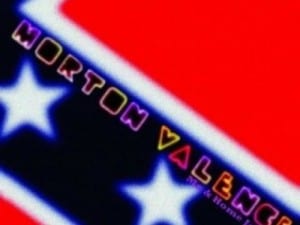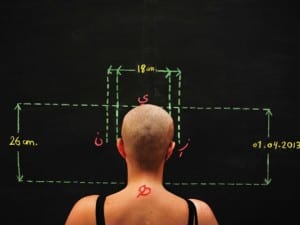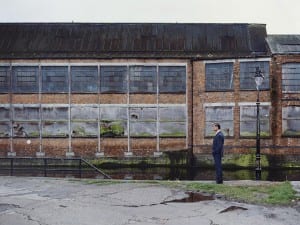Iain Forsyth and Jane Pollard stage a fictionalised 24 hours in the life of Nick Cave, replacing traditional rockumentary aesthetics with an exploration of how we spend our time on earth.
Songwriter, musician, author, screenwriter and composer, Nick Cave, is a true rock star best known for his mesmerising live performances and bizarre yet haunting lyrics. For 20,000 Days on Earth the famously camera-shy Cave collaborates with video artists turned feature film directors, Iain Forsyth and Jane Pollard, in a production which tracks a fictional 24 hours in Cave’s real life amongst his family and friends. Cave has described this day as “more real and less real, more true and less true, more interesting and less interesting than my actual day, depending on how you look at it.”
In under two hours we follow Cave through his home town of Brighton and his relationships with his family, through writing and rehearsing, performing and recording; through discussions with previous musical partners Kylie Minogue and Blixa Bargeld and actor Ray Winstone; and we reach into his past through sessions with psychoanalyst Darian Leader, and time spent in Cave’s archive – brought over from Australia and re-structured for the film.
While the personalities and conversations of 20,000 Days on Earth are genuine, it is not a docu-film; the situations and locations are wholly staged, a decision made by Forsyth and Pollard who affirm that they “never wanted it to look any other way.” Having always explored musicians, music and performance in a factual, documentary-esque manner in their visual art, the directors had long since identified a problem with realism in documentaries.
They continue, “You really can’t film truth. The medium itself is a lie. A construct. So our decision was to not fight that – we didn’t want to create a fly-on-the-wall sort of reality TV style film that purports to get ‘behind the mask’ of a rock star. There is no mask. If a rock star is any good, they become the thing they’ve created. Nick Cave is Nick Cave. We promise you there is not great insight to be gleaned from watching him make a cup of tea or drive his kids to school. Truth is a very narrow road for the imagination to follow. Warren Ellis should live on a cliff-top at the edge of the world. Whether he does or not is irrelevant. The truth doesn’t matter.”
In fact the fabricated home of fellow Australian musician and composer, and regular collaborator with Cave’s 30-year-old band The Bad Seeds, Warren Ellis is one of the fascinating characters within the film. Ellis is only present for a short time, yet he is key in “getting to know” Cave due to their close friendship and clear like-mindedness. Rather than communicate his personality through a staged conversation (the dialogue of the film’s discussions is improvised) the directors set Ellis up in a wild, historic coastguard’s cottage in Seaford. Ellis immediately becomes “on the edge of something, off the grid, and close to the elements” – he is the grounded counterpart to Cave, who wrote of their dreamlike album Push The Sky Away (2013): “Well, if I were to use that threadbare metaphor of albums being like children, then Push The Sky Away is the ghost-baby in the incubator and Warren’s loops are its tiny, trembling heart-beat.”
Push The Sky Away was, in many ways, the first set of plot points for the film as Cave, who writes on a daily basis, agreed to hand over his notebooks to Forsyth and Pollard. The directors explain that while inside those covers were the words that eventually formed Push The Sky Away, they also contained “fragments, notes, abandoned songs, sketches, half-baked ideas.” In amongst this they found a few things that ended up being quite pivotal in the film. One was the title of the film itself, 20,000 Days on Earth, which comes from an unfinished song lyric, and a calculation that Nick did that showed him to have been alive for exactly 20,000 days at the moment they started to record the album. “To us, it spoke of these bigger, grander and more universal ideas – pretty much centred on why we’re here, what we choose to do with our time on earth. So it stuck, and that phrase became our film title.”
The film, although based around a grey 24 hours in the south of England’s most popular seaside resort, is a study of greater things – as Pollard has commented: “The thing that is remarkable, that is inspirational, that affects you about Nick is his brain, his creativity, his ability to reframe and shape-shift the normal to make it truly vivid and moving” and speaks of the artist “constantly churning everything through the mill of imagination.”
To make a film that visually mirrors the process of a creative such as Cave is no mean feat; however, the directors use a series of conventions to do so: first, the blazing, energetic filmic montages which nearly blind viewers before and once during the film; and second, using short car journeys to divide and “reframe” between sections. These montages function like video art in their immediate ability to convey tone and set up an emotive response: playing before the titles roll onto screen, this short, raucous set of fast-paced clips releases a burst of Cave’s personality before the audience has even met him.
The opening sequence is a literal acceleration – in excerpts of concerts, interviews and behind-the-scenes footage – through Cave’s life right from day one to day 19,999. For Forsyth and Pollard, it was a way of saying “this isn’t a biographical film, this story starts now.” It is true that the film is not chronologically biographical; however, it rolls back and forth through Cave’s recollections – framed in these aforementioned car journeys.
These trips act in a way as an aside: voices materialise as friends from the past, sitting in the back of Cave’s car as he drives from one scene to another. These characters are Ray Winstone, who starred in Cave’s screenplay The Proposition; Blixa Bargeld, who performed alongside Cave in The Bad Seeds; and Kylie Minogue, with whom Cave performed the duet Where the Wild Roses Grow, his most successful single to date. The conversations between Cave and these individuals were completely improvised, and so the directors had to be – and were – prepared to fail, although the resulting intimate footage allows the audience to see Cave in a contemplative light.
Forsyth and Pollard hit on the idea of using the car as they had been searching for an imaginative space – a place where they could manifest the inside of his head. The car gave them a very pure and simple narrative device which kept the journey of the day moving forward, but also gave us them the chance to spin off into a more creative realm.
“We see these conversations like figments of Nick’s imagination. We wanted to be able to prick the reality of the film by having these characters appear and disappear without explanation. They’re all people who have touched Nick’s life in a particular way at a certain time and we chose them because we wanted to be able to bring out the different facets of his personality.” For example, Cave’s discussion with Kylie displays fond nostalgia, while Winstone talks to him about ageing, and Blixa, for the directors, represented the idea of moving on.
Cave had not seen Blixa for some years before he belted himself into the driver’s seat, perhaps since he left The Bad Seeds in 2003. Indeed, their collaboration had been a close and special one, and when it ended, they’d never properly discussed the reasons behind the break-up. Blixa just left the band. The directors hoped that bringing them back together might spark a conversation around the event while also exploring some new ideas.
The directors certainly never shirked an opportunity to delve – stating that “Nick threw himself completely at our mercy” – and the result is a film which goes far beyond Cave’s bombastic frontman façade. Forsyth and Pollard have worked with Cave on several projects before, such as promo videos for Nick Cave and The Bad Seeds, and the directors note that “it’s only the sort of trust that comes through friendship that enabled us to make this film.” The quiet moments and intimacies of the film are those that are the most precious to watch, however, Forsyth and Pollard affirm that this didn’t surprise them at all. “He’s actually quite an open person and willing to talk about most things. What we seemed to be able to do, which often isn’t the case with documentaries, is that we were able to make the process interesting for the subject. We’d have had no interest in making a film like this with Nick creatively at the helm, and we know he wouldn’t either.”
It is certain that Cave learnt about himself, his career and creative process during the making of the film, most noticeably in his discussions with psychoanalyst Darian Leader. Lying down on the couch and going through the recesses of your memory is stressful enough, without the camera rolling, so for this scene the set was constructed in such a way that equipment could all be screened off from Cave and the cameras were never in his sight-lines, which meant that he could focus on Leader. During the session, which lasted for 10 hours over two days, Cave is seen unpicking his relationship with his father and his adolescent romances amongst other things; as this stint is condensed through the edit, the audience see Cave joining the dots between his various pasts and his present in just a few minutes. This is just another of Forsyth and Pollard’s techniques for developing an alternative to an interview – no discussions with journalists, but with friends, acquaintances, family, psychoanalysts and even his own photographs and archival material.
For the film, a mass of materials from the Nick Cave Archive was hauled over from Arts Centre Melbourne, Australia, and laid out, piece by piece, in the vast, tiled basement of Brighton Town Hall; as Pollard explains: “We knew if Nick could spend two days randomly, or what seems to be randomly, pulling out objects and photos, there would be an authentic journey for him and it would become a way of unlocking a stream of memories.” Here audio and visual links are made between Cave’s musings with Leader and exactly what the artist pulls out from the piles of photographs that document his life: a paper-white female face, which is framed by black hair for example.
This image is conjured repeatedly throughout the film, first emerging during psychoanalysis as Cave’s earliest memory of a significant woman and then in his photography – most startlingly in the first photograph he had taken of his wife, which is projected across one wall of his re-imagined archive. Scenes such as this remind the observer of Forsyth and Pollard’s visual arts background, whilst also reaffirming that this is no ordinary documentary and that, vitally, it is staged. The audience trust that the conversations of Cave and his contemporaries are truthful and natural, but this is itself open to dispute as all the contributors were aware that the film is, at its core, an ode to creativity and an exploration of the process of innovation.
This slant was, in part, due to the influence of James (Jim) Wilson (Under the Skin, Shaun of the Dead), an independent film producer, who bolstered the directors’ confidence by bringing a belief that the film could be much bigger than a Nick Cave biography, he encouraged them to reach much further and, to tell a much bigger and more universal story. Forsyth and Pollard explain: “Jim loves cinema as a medium, and truly believed in the idea that you can make great Art, with a capital A, without having to be pretentious.”
The most poignant moment of Forsyth and Pollard’s film is seeing Cave himself perform what is his own “art,” in a live performance at London’s KOKO. Although far removed from the scale of usual Bad Seeds’ gigs, watching Cave touch, speak to and truly connect with a small and intimate audience is somewhat overwhelming. After an hour and a half amongst Cave’s musical family, immersed in his memories and subjected to his mind, his lyrics take on greater context and meaning: once on stage this pensive subject becomes Nick Cave, renowned rock icon, once again, in this transformative moment that is right at the very heart of what the film is about.
20,000 Days on Earth is released in cinemas on 19 September. For further details about the film please visit www.20000daysonearth.com.
Chloe Hodge





